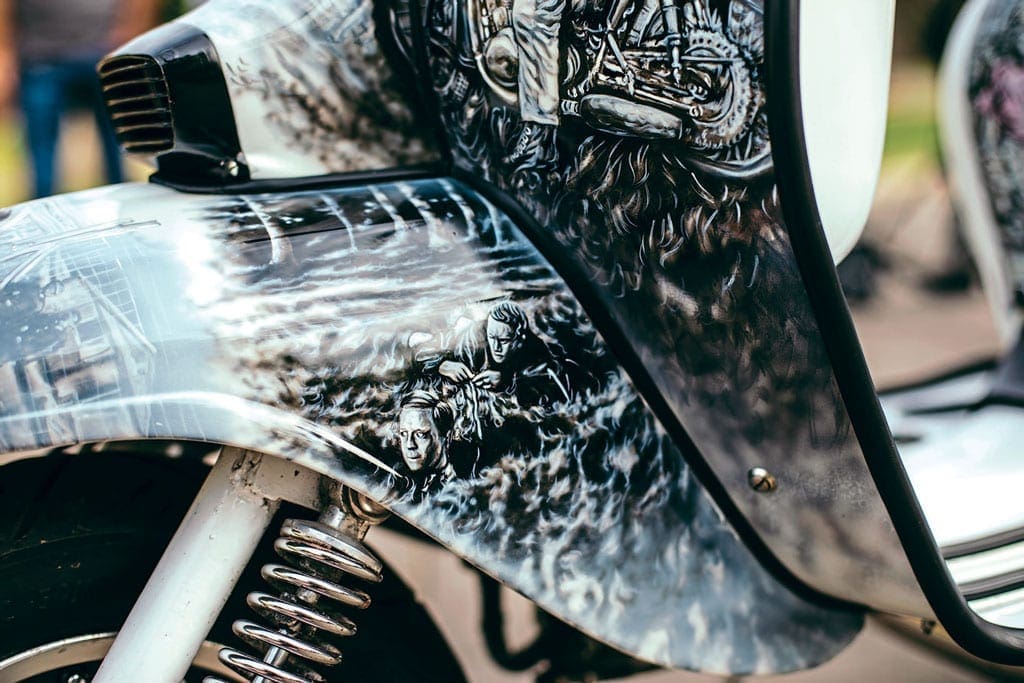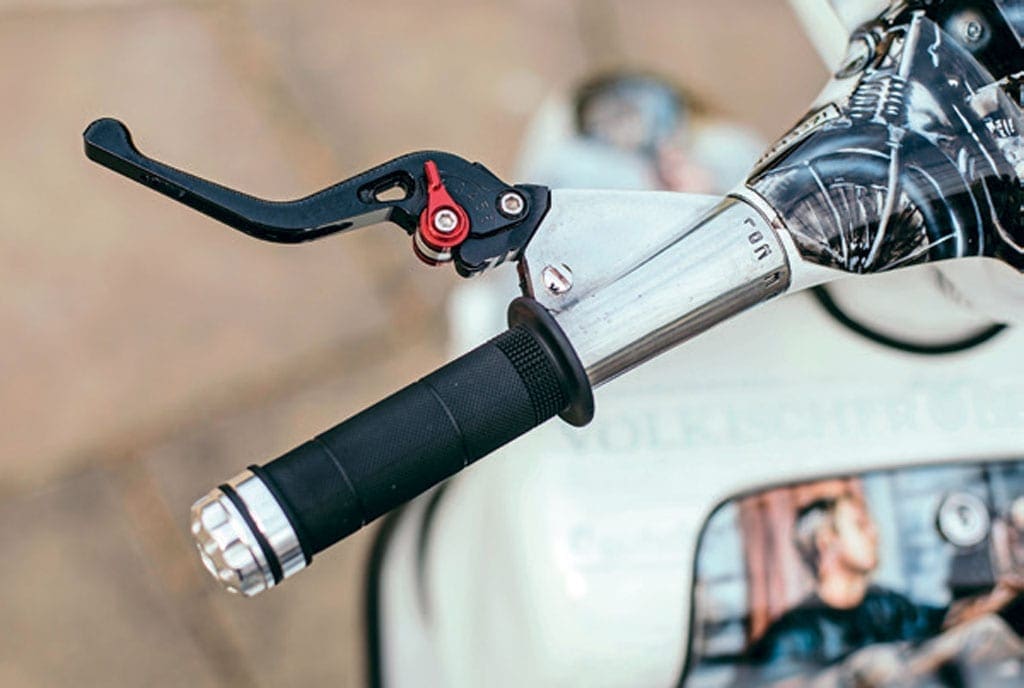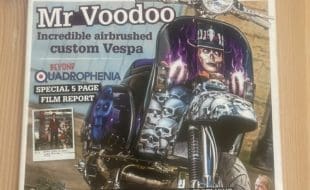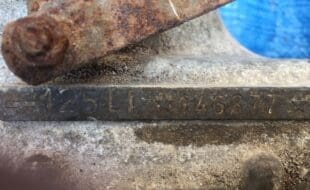
Words: Stu Smith | Photographs: Gary Chapman
The Great Escape is a truly classic movie, which at some stage had to be developed into a themed scooter.
It’s one of those movies which, once you’ve watched it, never leaves you. As we all know, The Great Escape is a war movie and not a romantic movie, but the journey to the completion of Bob Bush’s ‘Great Escape’ themed scooter is a story born out of true love and affection.
Bob Bush has been into scooters since he was 16, but as he grew up the usual family and professional commitments took priority and scootering had to take a back seat for a while. However, as all of us know; you never lose the scooter love.
Enjoy more Scootering reading in the monthly magazine.
Click here to subscribe & save.
In 2008, Bob bought himself the scooter which would later become ‘The Great Escape’. It initially had a blue and check colour scheme, which after a while Bob changed to red, white and black. The scooter was nice, but in the back of Bob’s mind he’d always wanted to own a custom scooter.
Bob’s wife Karen has been with him throughout most of his scootering days and has always been aware of his dream so, as a gift to Bob for their Pearl Wedding Anniversary (July 25, 2017), she decided that she’d take the opportunity to pay for Bob to have a custom paint job on his scooter to the theme of his choice.

Considerations
Bob was delighted when Karen broke the news to him. He explained that he’d considered having a Motown theme for the scooter, but having sat down with Karen and gone through all the other possibilities he decided that the best theme for the scooter would be his favourite film; The Great Escape.
Background
Quickly, for anyone who’s not seen the film: The Great Escape is based on the prison camp Stalag Luft North, which opened in 1943.
The camp was a maximum security prisoner-of-war camp, designed to hold even the craftiest escape artists. In doing so, however, the Nazis unwittingly assembled the finest escape team in military history who worked on what became the largest prison breakout ever attempted.
The film has various ‘specialists’ throughout, who form integral parts of the escape team who support and work on three tunnels simultaneously, calling them, ‘Tom’, ‘Dick’ and ‘Harry’ while one of the characters, USAAF Captain Virgil Hilts (Steve McQueen), the ‘Cooler King’, irritates the guards with frequent escape attempts and irreverence.

Making the choice
With a fantastic set of well-known and accomplished actors to choose from; all of whom played significant roles and characters in the film, Bob needed to decide which character he would choose to deliver the theme in the best possible way through the artwork.
“I needed to choose the character who brought the most to film, the one who was the most exciting and the one who was the most daring. It had to be Steve McQueen,” Bob explained.
The motorcycle scenes, which Steve McQueen is involved in are probably the most widely seen and probably the most memorable motorcycle stunt scenes in the history of film making; and how apt that the bike used in the film in the attempt to escape from the Germans is a British bike, a 1961 Triumph TR6.
Artwork choices
With the theme and character choices made, Karen and Bob approached Dewey Franklin to complete the artwork; “I’d seen Dewey’s work, it’s absolutely fantastic, his attention to detail and his portrait work is sublime; I knew his style would be perfect for the scooter,” Bob said.
Dewey agreed to take on the job and Bob now had to decide, which images he would use. “The scooter needed to tell the story of the overall theme of the film, but it also needed to tell the story of Steve McQueen’s character (Virgil Hilts) in detail through a sequence of images,” Bob explained.
Dewey has taken this brief and has intelligently used the surface area of the scooter to maximise the delivery of the theme.

Amazing artwork
You’re first drawn to the artwork by The Great Escape graphic on the offside legshield. Then the mural on the headset top, which is of Hilts tightening the chin-strap on the German motorcycle rider’s helmet, just moments after he’s dismounted him from his bike using a section of wire tied between two posts across a country road opens the theme.
The mural of a guard tower on the horncast then divides two classic images: The one on the offside of the legshields shows the scene where Hilts is deep in thought planning how he’s going to make his bid for freedom having just ridden up to a German border control check-point.
Follow this mural down the legshields and Dewey has blended it from the legshields into the lower section of the horncast and the corresponding area of the front mudguard without losing any of the flow of detail.
Work back to the horncast and you’re led over to the other main mural on the nearside legshield, which is a tribute to Steve McQueen and shows him with his arm extended; on location engaging with the film crew during the filming of the motorcycle stunt scenes.
Dewey then blends this mural briefly back to the horncast where it then effortlessly moves into the mural on the nearside of the front mudguard, which is of Hilts having escaped from the camp, out of the tunnel into the woods and is using a rope to indicate to Roger Bartlett when it’s safe to make his run for freedom.
The mural on the top of the front mudguard, which shows Hilts standing pensively in front of the prison camp gates then takes over and gives an inference of what’s to come…

The motorcycle ‘jump’ scenes
The artwork on the sidepanels has been cleverly planned to deliver the timeline of the motorcycle ‘jump’ scenes. It starts at the lower section of the offside sidepanel where Hilts stops for a moment to check on his pursuers and looks for the best location to jump the border fences.
Having made his choice he begins his run, which is illustrated in the upper offside sidepanel where Hilts clears the first of the two border fences. With only the higher, and final border fence to clear you’re moved over to the nearside sidepanel, which delivers two murals.
For impact; the lower mural is in black and white and the upper is in colour and they capture the moment where; after being shot at by a German soldier in a motorcycle side car unit Hilts crashes into the barbed wire border fence just as he was about to attempt his last jump for freedom.
The frame toolbox then shows the scene where; having been captured at the border fence Hilts is led back to the cooler and is greeted by the on-looking prisoners. To support the theme of ‘Cooler King’ there are additional murals on the legshield toolbox.
On the main body of the toolbox there is a mural of Hilts being led down the cooler corridor by German guards who are bemused by his resilience and numerous escape attempts, and on the toolbox door there is a mural of Hilts in the cooler throwing his baseball against the wall to pass the time and think about his next escape attempt.
The parting shot from the artwork is through a thought-provoking mural behind the rear frame grill of Hilts in the cooler, which is supported by a plaque attributing the artwork to Dewey.
The story told
No matter whether you’ve seen the film or not The Great Escape’s artwork will leave you amazed. Dewey’s work is jaw-dropping; it’s unbelievable in detail and the theme is delivered perfectly.
Bob said; “I can’t thank Karen and Dewey enough for giving me the custom scooter of my dreams. Karen and Dewey are both fantastic people and I can’t describe how much I appreciate what they’ve both done for me.”

Enjoy more Scootering reading in the monthly magazine. Click here to subscribe.
Scooter Trader





